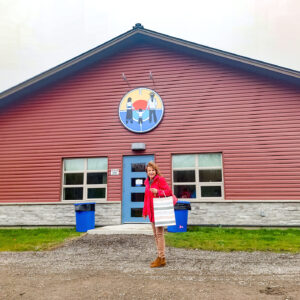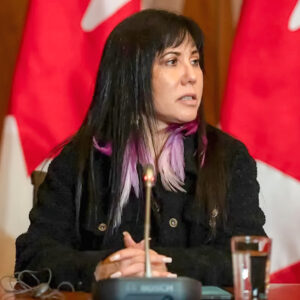
By Jim Windle and Nahnda Garlow
BRANTFORD – The recent discovery of skeletal remains of more than 215 former students of the Kamloops Indian Residential School has caused a stir across Canada, but more specifically in Brantford where the first residential school in Canada opened in 1832.
The discovery was announced on Thursday by the chief of the Tk’emlups te Secwepemc First Nation, who had investigated the grounds of the old school themselves.
Now, Six Nations is renewing a call for examination of the ground of the former Mohawk Institute Residential School in Brantford.
It has been rumoured for generations that similar undocumented burials may have taken place at the Mohawk Institute.
Now, Six Nations Elected Chief Mark Hill is calling on the federal government to deliver capacity for Six Nations to search the grounds.
In an open letter to Prime Minister Justin Trudeau, Hill writes, “Six Nations of the Grand River is the largest First Nation in Canada and we are calling on you, Prime Minister, to take action in equipping Six Nations to immediately conduct a comprehensive search for missing children on and around the grounds of the former Mohawk Institute. I am available to speak with you directly to discuss how we can expedite the search using the latest ground penetrating radar technology. We must find all of our missing children.”
Hill called on the Prime Minister to take action on the Truth and Reconciliation Commission’s Calls to Action numbers 71-76 on Missing Children and Burial Information.
Canada’s Truth and Reconciliation Commission focused on those losses in the “Missing Children and Unmarked Burials Project with shocking discoveries.
Of the 3200 deaths the TRC discovered; 32% of those deaths were not recorded and 49% did not have the cause of death recorded. Even more distressing — though Indian families were, by law, ordered to send their children to residential school by age 7 — there were zero protocols in place to send children home upon their death and no basic health and safety standards in place to ensure their wellbeing. In fact, most children who died at residential school were buried at the school and all too often those cemeteries are now abandoned and unmarked.
The TRC’s report on unmarked burials notes that a 1914 department official noted that “fifty percent of the children who passed through the schools did not live to benefit from the education they had received therein”.
This is well known fact in Indigenous communities across Canada, and at Six Nations.
A few years ago, when a group known as the Mohawk Workers took over the former Kanata Village museum, they began searching for evidence that would prove or disprove these rumours and first-hand accounts.
At that time, a defrocked Christian minister named Kevin Annett was on the trail of the Kamloops story which just broke this past week. Annett wrote a book on his findings and produced several videos under the title, ‘Unrepentant’.
In both, he interviewed many former students from the Kamloops residential school and published horrific stories about their time at the Kamloops school. After finding abundant evidence of the systemic genocide of Indigenous culture, language and even life, he began searching other residential schools and spent months in Brantford researching the Mohawk school, as a guest of the Mohawk Workers.
Six Nations loaned ground-penetrating radar equipment to the Mohawks to scan for possible graves around the current school building. Although nothing was found in the section searched behind the girl’s wing, much of the rest of the grounds were not. Due to backlash from some members of Council and some former students, the search was canceled and the equipment returned.
Annett’s findings were sometimes exaggerated and at other times, completely wrong. He was accused of using Six Nations’ sorrow — self-aggrandizing to enrich himself — though his books are available online free.
Other First Nations communities he traveled to for research also began to question his motives, but much of his research and documentary evidence was, as it turns out, accurate.
After prematurely publishing a story that they had found human bones in the school’s incinerator, later found to be animal bones, Annett lost the confidence of the Mohawks and he eventually moved on. However, Annett did leave behind documented cases of the maltreatment of former students while at the Mohawk Institute and other residential schools.
Now, given the findings in Kamloops, a look for former students in unmarked graves buried at the Mohawk Institute is getting another look.
One of the reoccurring community stories involving the Mohawk Institute are the accounts of former students who claimed there were babies buried beneath the apple trees in the school’s orchard.
As part of the Woodland Cultural Centre’s revitalization and Mohawk Institute Memorial Park plans — those apple trees were removed and an archeological investigation was done of the area which, thankfully, did not uncover any human remains.
There is still a lot of investigation left undone at the Mohawk Institute which the Kamloops revelation might rekindle. One such story is of children’s burials being located in the strip of brush and trees which lies between Mohawk Park and the Glebe Land, which still belongs to Six Nations. This small parcel of land has been kept pristine despite this region of the Glebe land being developed as a military camp during the War, which may indicate that even the city may have knowledge of these burials and didn’t want it disturbed.
There is one community account from a certain Six Nations man, who claims to have uncovered some of these graves himself and locating a few cornhusk dolls in the dig. Others say there are unmarked graves of children on the Mohawk Chapel grounds.
There are several archival reports of children at the Mohawk Institute passing away from consumption, the Spanish Flu, or runaways dying of exposure. Some of those lives lost were fully documented and the children were transported home to their parents for burial, but some were not. How those children died and where were they are buried remains a mystery.
Only a small portion of the Mohawk Institute grounds have been searched with GPR equipment to date.








